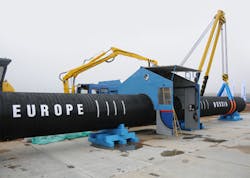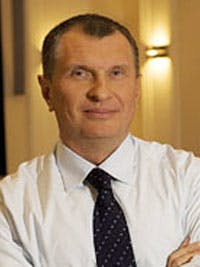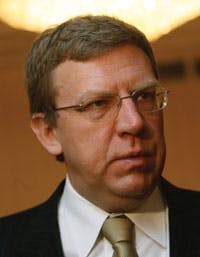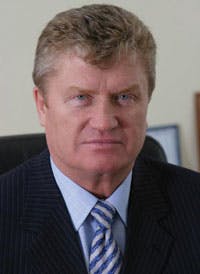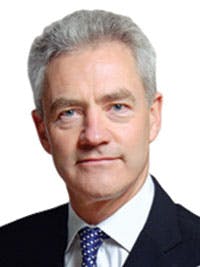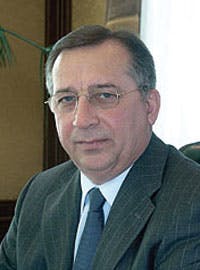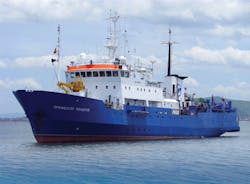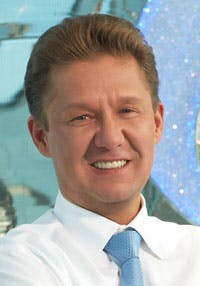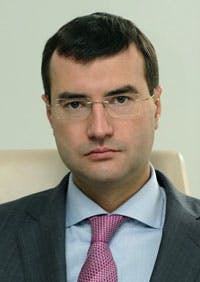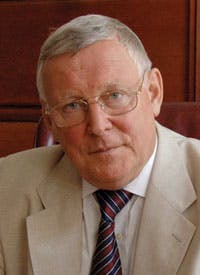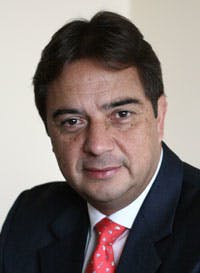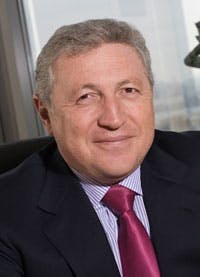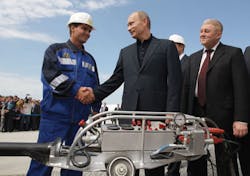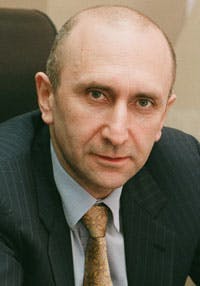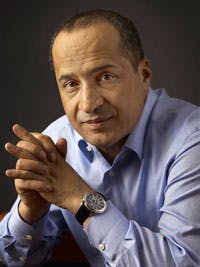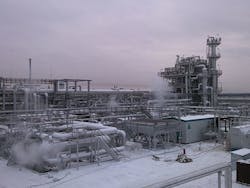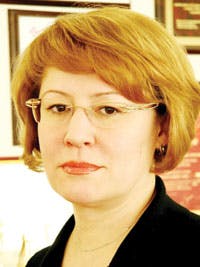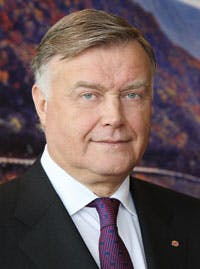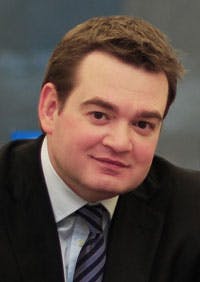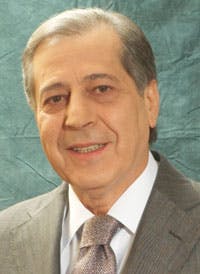The real face of Russia
| This sponsored supplement was produced by Focus Reports. Project Director: Henrique Bezerra. Project Coordinator: Olivia Scarlett. Editorial Coordinator: Karim Meggaro. For exclusive interviews and more info, log onto www.russiaenergy.com or write to [email protected] |
The real face of Russia is a difficult concept for those unfamiliar with the country: an energy superpower grappling with the challenge of redefining itself for the 21st century. Part of the problem is that old stereotypes prevail where they should not. Russia is keen today to show itself as a country bursting with potential, as open and transparent as any other market across the globe. Although a lot still needs to happen before the world begins to view Russia in this way, the current situation means that for those who are not risk-averse, the market holds much potential. It is clear that Russia's key oil and gas decision makers, although focused in different areas and on different challenges and opportunities, are all working towards one common goal: making Russia a strong energy player for the sake of the economy, for business and for its citizens.
Different Focuses — One Aim
"Russia is currently the number one oil producer in the world. And of course expanding oil exports is of fundamental importance to us, since this is where our core budget revenues come from," Deputy Prime Minister Igor Sechin recently stated. By keeping production levels at the end of 2009 above 10 million barrels, the country overtook Saudi Arabia to become the world's biggest producer of oil.
As well holding this enviable position, Russia also holds 32% of the globe's proven gas reserves and is the largest exporter of gas. The global gas market in 2010 looks very different to a few years ago, due to the rising importance of shale gas in the US market and predicted slumps in global demand. Gas has always been indexed to oil prices, but gas prices stood at around U$ 4.6 per British thermal Unit (BTU) at the end of June 2010, twenty times less than the current oil price. Historically, it has always been closer to ten times less. Despite this situation, at the most recent meeting of the Gas Exporting Countries Forum, Russian Energy Minister Sergey Shmatko stood against putting quotas on production, an alternative to indexation. "All ministers agreed and supported that we continue our efforts to achieve indexing gas to oil," he said after the forum.
AlexeY Kudrin, First Deputy Prime Minister and Minister of Finance
New pipeline projects to extend and diversify Russia's export reach are positioning the country in a new light: as a major supplier to Europe and the CIS through projects such as the Caspian Pipeline Consortium (CPC) Baltic Pipeline System (BPS), as well as gas through Nord Stream and South Stream. Valery Yazev, vice chairman of the State Duma, Russia's equivalent of the United States House of Representatives, explains the need to develop such projects when there is already pipeline capacity to Europe. "By 2020 Russia will need to transport an additional 100bcm of gas per year to Europe and that is what North Stream and South Stream are meant for. They are additional transport routes, which will diversify the transit system and reduce the dependence of Russia and European countries on countries such as the Ukraine, which have caused transport problems in the past."
Oil and gas are clearly hugely important for the Russian state budget. Although Finance Minister AlexeY Kudrin has been pushing for some time for "ending dependence on oil", Russia's 2009 budget was contingent on oil prices reaching U$ 95 per barrel. When this did not happen the country's reserve fund built up during the boom years had to be used, which meant that oil and gas revenues accounted for 11% of GDP and half of the country's spending for the year.
The Russian government is also looking at reshaping its oil and gas taxation system. The current system taxes upstream production but allows companies to make their money in refining and downstream activities, essentially fostering an environment where only Russia's largest integrated players stand to benefit. A new taxation model would look to stimulate growth across the energy value chain and encourage the development of smaller oil and gas companies more suited to exploiting mature deposits in Western Siberia. Encouraging the development of junior companies in Russia has been an issue for the last few years, as Yuri Shafranik, former Minister of Fuel and Energy (1993-1996) and today chairman of the Union of Oil & Gas Producers of Russia explains. "In 1996, 16% of Russia's total production volume belonged to small and medium companies. Today, that percentage hardly reaches 2%. Small business today is burdened with tax. We realize this problem and our mission is to analyze the issue and try and persuade the Government and the State Duma that it is very important and that resolving it is in the national interest."
As well as addressing this issue and making sure that Russia capitalizes on fields that are not of strategic importance to the major players, any new taxation system must also encourage Russian companies to exploit promising new regions such as East Siberia. The new taxation model must also acknowledge the current issue in convincing investors that moving to these new regions is worth the investment. This may take the form of a revenue-based tax system, or continued tax holidays for specific fields, but will have to take pains to maintain a balance between incentives for upstream and downstream operations.
The energy sector as a whole has undergone some major changes over the last decade from commodity producers to consumer facing power generation companies. Yuri Lipatov, chairman of the State Duma Committee for Energy has overseen many of these changes, including the liberalisation of the power generation industry. He explains that in the end these changes should always be concerned with improving the experience of the end-user. "We hope that the philosophy of the law will, at the end of the day, form competitive pricing, which in turn will allow reducing costs and introducing lower prices. We, as state representatives, should use our power to ensure smooth improving of the legislative machine in case of problems."
Marching on Moscow
Despite the challenges of the market, Russia is a major recipient of investments from the world's biggest IOCs: ExxonMobil, Total, BP, ENI and the world's biggest service and equipment providers such as Siemens and GE. It seems that for some the Russian market is not as cold, unattractive and impenetrable as many perceive it to be.
Companies like BP, for whom Russia accounts for 25% of its production, just over 10% of its profit and around one fourth of the reserves bookings leave no doubt that with all its risks Russian shores can still be much safer than elsewhere.
David Peattie, head of BP business in Russia, describes the commitment that his company has made to the Russian market through TNK-BP, their joint venture with AAR (Alfa-Access-Renova Consortium) as well as the company's current attitude towards its Russian investments: "TNK-BP has paid over $110 billion in taxes and duties in Russia, and has paid a significant amount of dividends to its shareholders. It has had its challenges, but we think the industrial logic behind the original conception, which was bringing BP's leading technology in oil and gas field developments and exploration together with our partners' ability to get things done in a Russian context through their relationships and their knowledge of Russian infrastructure and politics is a winning combination. It has been very successful by any measure."
As well as committing to its JV through some difficult times, BP has strengthened its links to Russia through its aviation fuels, trading and lubricants business, and also by purchasing a 1% stake in Rosneft. This strategic investment will undoubtedly help BP in Russia in the years to come in terms of working with Rosneft in some of the country's most crucial future projects.
Looking East to the Land of Opportunity
For the Russian oil and gas industry, the east of the country is a region that holds vast reserves of oil and gas and the potential to drive Russia's energy industry for many years to come across the whole value chain. And yet the east represents so much more than this. It is here that Russia shares a border with China, a country developing so quickly that even its own vast natural resources are not enough to fuel its growth.
As the president of Transneft, Russia's national oil transit company, Nikolay Tokarev is optimistic about the potential for Russia in the East. The company is currently engaged in one of the largest projects since Perestroika to link Russian oil to the Asian market. The ESPO pipeline opened its first stage in December 2009 and at the time Prime Minister Putin called the project "a great New Year gift to Russia." Tokarev agrees. "We're already witnessing the booming development of the regions adjacent to the pipeline: construction of roads, electricity transmission lines, new settlements, and, most importantly, development of new oil fields."
Togrul Bagirov, executive vice president of the Moscow International Petroleum Club, a group that aims to encourage the participation of the key international players in Russia's oil and gas sector, acknowledges the importance of Asia in developing Russia's long term export strategy. Whilst many economies eye China warily, the Russian attitude seems to be that a market of China's size can only bring opportunities, and that these will not be realised through confrontation, but through cooperation and engagement. "Oil and gas is also quite a strong and effective mechanism for a country's foreign policy and developing relationships with other countries," explains Bagirov. "Russia has become one of the biggest players in ensuring energy security in Europe and globally. China needs Russian energy if it plans to be the strongest economy in the world."
Arctic Dreams
Meanwhile, in the chilly northern city of Murmansk, an industry holds its frosty breath, pinning its hopes on one of Russia's key oil and gas regions — the Russian Arctic Shelf. The litmus test for the viability of projects in this offshore region is seen by many to be the development of the Shtokman gas field, which is still awaiting a final investment decision by Gazprom and its project partners Statoil and Total. Despite this decision still being some months away, a vast array of service providers and equipment producers have shown interest in the Murmansk region over the last months and years. There is much potential in the Russian Continental Shelf — covering 6.2 million square kilometres, it is estimated to hold 100 billion tons of oil equivalent.
However, Murmansk is also home to some very well established companies that have been faithfully serving the oil and gas sector for many years. Russia's interest in the Arctic region is not as fresh as the lack of producing fields might suggest. As early as the 1970s, the Soviets began geological expeditions to survey the seas of the Russian North. Infrastructure for data processing was put in place in the city of Murmansk, and over 740 vessels were constructed within the USSR and neighbouring countries. By 1979, the Soviets had decided to split the task of mapping the Russian Shelf amongst different organisations in order that the work might be carried out more thoroughly. It was at this time that the Murmansk companies Sevmorneftegeofizika (SMNG) and Marine Arctic Geological Expedition (MAGE) were given their exploration mandates by the Soviet government.
It was during the following years that these companies mapped the entire Russian shelf, and Russia's giant offshore fields such as Shtokmanovskoye and Pirazlomnoye in the Barents Sea and Rusanovskoye and Lenindgradskoye in the Kara Sea were discovered. Once this work was done, companies such as SMNG started to look elsewhere for markets where they might apply their expertise. Konstantin Dolgunov, general director of SMNG, explains. "In the late 1980s the management of Sevmorneftegeofizika realized what our situation of having the state as our only customer was fraught with, and that at some point the order book would dry up, and SMNG would be left with over 1,000 employees and no work to give to them. So as early as before the collapse of the Soviet Union, we started to look to international markets to source new business." SMNG worked with NOPEC and CGG on the Norwegian shelf, applying the skills they had gained to a region with similar geographic conditions. Although at this time their fleet did not comply with international standards, it was upgraded in the 1990s and today SMNG works all over the world with some of the industry's largest producers.
Gennady Kazanin, General Director of MAGE
Despite the work that was done mapping the Russian Shelf at the end of the 20th century, Russia has yet to fully capitalize on its offshore reserves. As the Russian Shelf is considered one of the country's strategic regions under current legislation, the only companies that can compete for tenders there are Gazprom and Rosneft, as the only Russian companies with more than five years offshore experience. Licenses have been awarded, but work has not yet begun on many of these fields beyond the basic exploration stage. Gennady Kazanin, general director of MAGE, another company with decades of experience of mapping the Arctic region, explains why development of these offshore assets is not currently a priority: "The current lack of infrastructure, pipelines and refineries close to the Russian shelf to facilitate the production for companies that want to operate there means that capitalizing on these assets will require very high levels of investment, in order to put the necessary amenities in place. This activity is already progressing on some projects, such as the Shtokman development." He goes on to explain that this difficult situation means that Russia's offshore region will not be a priority for Rosneft and Gazprom whilst they have assets onshore that are easier and cheaper to extract.
However, the Russian government seems keen to explore the possibility of opening the shelf to private companies. The most recent data shows that in order to develop the shelf until 2040, more than 6.3 trillion roubles (U$ 207.3 billion) of investment will be needed. Given these figures, the Ministry of Natural Resources estimates that at their pre-crisis investment levels, it would take Gazprom and Rosneft 165 years to develop the shelf alone.
Sergey Donskoy, Deputy Minister of Natural Resources and Ecology of Russia, explains the government's current strategy for finding a solution to this issue: "We're looking to expand the list of companies allowed to get licenses for development of the offshore fields. We also suggest the idea of creating consortia and the possibility of increasing the number of operators at the expense of the affiliates of Gazprom and Rosneft, as well as other ways to let the state control the management of developing the fields in order to maximize the public benefit and revenues, attract more Russian contractors and ensure transfer of innovative technologies in the frame of attracting the foreign contractors for offshore development."
Companies have realised how this change in mentality might be important for the development of the oil and gas industry in the Arctic. As Konstantin Dolgunov of SMNG explains, "If, as today, access to the Russian Shelf continues to be closed to Western companies, we'll continue pursuing our current strategy of looking for customers both on the world oil market and on the Russian shelf and establishing the reputation of a reliable and qualified contractor." Despite testing times for these companies that established their reputations and expertise on Russian Arctic waters, both SMNG and MAGE are still sourcing some of their work from the region. MAGE currently fills around 60% of its order book with Arctic survey work.
As the Russian government ponders whether to open the Arctic shelf to other oil and gas companies, foreign geophysics companies are also targeting this promising market.
PGS' core international focus is deepwater geophysical surveys. However, in Russia PGS has been working for more than eleven years in mostly shallow locations in the Caspian and Far East regions. The reason for this is that, as Alexander Dementiev, the head of the representative office of PGS in Russia explains, "In terms of regulations, the Caspian region is more open towards foreign contractors since it has had to adapt to the fact that many countries share the shelf. Of course the shallow water services that we offer in the Caspian are not the core business of PGS on the global market. Our recently launched PGS vessels of Ramform S series can theoretically tow up to 22 seismic streamers. So it means such vessels can do high quality 3D acquisition over considerable areas in one go. This should be a very competitive advantage in such regions such as the Barents Sea and the Okhotsk Sea in Russia."
These vessels are able to work without refueling for up to five months, so it means they don't have to call at a port during a typical survey. "The only reason we haven't been able to use these vessels, or PGS' other 3D vessels, and have been focused only in the shallow waters of the Caspian is because there are still some restrictions for use of vessels under foreign flags on the Russian shelf", Dementiev complains.
According to him, the Russian Arctic shelf represents huge long-term potential for geophysical marine companies as it has not yet been properly explored. "There are some issues that we are trying to understand, but which are still unclear. Geological exploration is listed as a strategic activity; as such, foreign companies cannot efficiently compete on this market, posing a big problem to Russia itself. Russia's shelf development plans are ambitious; however the geophysical fleet is rather outdated. This makes efficient exploration of the Russian shelf without the support of foreign technology quite challenging."
Yes, the North Can
Since its discovery in 1988, the massive Shtokman field in the arctic Barents Sea has been presented as the future of the Russian oil and gas industry. The massive reserves found up north only add to those found further east in the Yamal Peninsula and reinforce the feeling that Russia should press ahead with oil and gas exploration in such a promising region.
Gazprom, the protagonist in both mega projects, has continuously defended their viability. AlexeY Miller, chairman of the Gazprom Management Committee recently stated that "the immense resources of the Yamal fields will become one of the main factors contributing to steady development of the entire Russian gas industry for the decades to come. It is the comprehensive approach to the Yamal fields development, infrastructure sharing and time proven partnership that will allow implementing these projects with maximum efficiency."
Companies like Trelleborg, the biggest non-tire rubber company in the world, see potential in the further development of the Russian Arctic Shelf. In the words of Julia Malafievskaja, general manager of Trelleborg Industry in Russia, "Trelleborg has a wide range of products that will be necessary in order to fulfill the Russian ambitions of developing its offshore fields. We are using international technology with no parallel in the local market, the reason why Russians are open to partnering with us and using our technology for key projects".
The company is a market leading designer and manufacturer of marine and offshore solutions for topside, surface, subsea, sea floor and down-hole applications and their main products include surface and subsea buoyancy, thermal insulation, clamping and solutions to protect critical equipment against fire, over-bending, impact, corrosion, vibration and abrasion: all critical for the development of a climate challenging region such as the Arctic.
Good Vibrations
The Russian geophysics sector experienced a slowdown during the economic crisis as producing companies looked to slash their costs, often cutting budgets for seismic surveys. Alexander Lyandres, Moscow Processing Center manager of CGGVeritas, recognizes the strong impact the crisis had over the company's business in Russia, but highlights how CGGVeritas managed to secure its position in the Russian market. "In Russia, the business climate has not been too difficult for CGGVeritas because we understood the potential of doing not only data processing but also interpretation, something that in the West most oil companies do, but not in Russia… even with the crisis, companies cannot just shut down new production immediately, which means that you have to continue with interpretation and reservoir work."
Mr. Lyandres still believes in the potential of Russia's primary production region. "West Siberia is very well explored but there is still a lot left to do there. A good example is TNK-BP, which is doing a lot of seismic work in Western Siberia and has been quite successful. We don't know what the future of gas prices will bring, but despite this, there is still considerable activity in Yamal: Gazprom and Novatek are already operating there, as well as Total and ENI, and many new players are on their way to the region."
The crisis also opened the doors for groups that invested heavily in the consolidation of Russia's seismic and geophysics market. Geotech Holding, by far the Russian seismic market leader with a 42% market share, managed to achieve such a figure in only 4 years after its creation thanks to a series of acquisitions made under very favourable market conditions. Some of the companies acquired had more than half a century of experience in the oil services market. "This led us to employ more than 12,000 people today and become one of the largest and most experienced onshore seismic service providers in the world. Our current capacity allows us to carry out any project in the shortest terms. For instance, we have accomplished the largest project in Russia covering 1,700km2 over one winter season. We're ready for any projects of any size in the shortest term," celebrates Nikolay Levitskiy, president of Geotech Holding.
Now the company is betting its expansion on exploration drilling and onshore geological exploration. "We're confident that exploration drilling in Russia will expand and Geotech Holding will make its expertise and leadership in exploration drilling comparable with that which we already have in onshore seismic exploration," Levitskiy says confidently.
For Levitskiy, Geotech Holding's main competitive advantage is its vast experience and knowledge of the territories where it has been operating for many years: East Siberia, Yamal, Timan-Pechora and Western Siberia. "Geotech Holding's main task is to comply with the highest international standards while offering the most experienced and vast coverage of the Russian market, making Geotech Holding the partner of choice over all other competitors, foreign and Russian."
As well as looking to increase its international customer base within Russia, Geotech is also looking to move beyond the borders of its domestic market. Levitskiy explains that "Traditionally, geological exploration has been very well developed in Russia, and Geotech Holding, as the Russian leader in geological exploration, should keep its market share in Russia, develop offshore and onshore projects internationally and possibly carry out exploratory drilling. In this regard, we want to implement a lot of international projects beyond Russia and the CIS, such as in Latin America and South-East Asia. Our task is to be part of the global community and keep up with the largest Russian oil and gas companies. In this regard, we'll expand in the West to participate in international projects to demonstrate the capacities of Russia."
Despite recent problems, many in the industry see 2010 as the year when exploration will get back on track. In Russia, the average budget increase by producer companies for geological exploration this year is between 5-10%. TNK-BP intends to spend U$ 400 million on geological exploration in 2010; U$ 180 million of this has been earmarked for seismic acquisition. Rosneft will do 50% more 3D seismic work in 2010 compared to the year before.
Dr AlexeY Kashik, General Director of Central Geophysical Expedition
In this slightly more cautious post-crisis period, the size of the market for seismic acquisition may actually be set to grow: seismic acquisition and interpretation is much cheaper than exploration drilling, and advanced new techniques can vastly improve the chances of drilling success, thus reducing the chances of drilling a dry well. Companies such as the Russian ANCHAR, through developing new technologies to improve drilling efficiency, have become partner of choice for Russia's major oil and gas players. Sergey Arutyunov, general director of ANCHAR, explains why his technology has proven so popular: "In traditional geophysical surveys, seismic exploration gives an impression of approximate areas where oil and gas could potentially be located, but there is no definite answer to whether or not there are reserves until the exploratory drilling stage. ANCHAR was created to seek out oil and gas with more certainty, which means eventually that E&P companies can drill wells with less risk, and choose from fewer potential fields."
For AlexeY Kashik, general director of the Central Geophysical Expedition (CGE) with more than 40 years of experience in the company, the way to survival didn't include consolidation; instead the company relied a great deal on its in-house expertise and constant innovation. According to him, CGE (the company once responsible for the digital recording and processing of all geophysical data in the Soviet Union) has survived and grown out of all major economic and political crises thanks to its unique investment in innovation. Mr. Kashik has 150 publications and 50 patents under his name alone.
"CGE's unique emphasis on innovation led it to successfully carry out up to 50 projects a year, creating seismic and geological models, through proprietary developments in design and mathematics. We develop and support our own in-house software. In terms of technology, western software may be more advanced but our software is more oriented towards the depth of processes. Since technology for oil production is constantly evolving, you always have to look for new means of processing and our programmers are able to swiftly adjust the software according to the new conditions: this is one of our core strengths. CGE can accommodate all sorts of different solutions and needs to the satisfaction of our customers" underlines Mr. Kashik. As a result, CGE is one of few Russian companies able to support its proprietary software products for geophysical modelling.
Silver Service
Seismic is an area that has been highlighted by Russian Oil Field Service (OFS) provider Integra as having particular promise this year. CEO of Integra Antonio Campo explains how seismic fits into his company's business plans for 2010: "Although prices are a little weak due to the problem of oversupply, we see a very good indication that that market is growing. The rest of Integra's services naturally follow seismic surveys and both the technology and the drilling/workover and Integrated Project Management (IPM) divisions are showing signs of improvement."
Integra is Russia's largest integrated oilfield service and manufacturing group. Incorporated in 2004 under the direction of Felix Lubashevsky, the company capitalised on the trend of consolidation within the Russian OFS sector, acquiring 17 companies over the last six years and growing to over 17,000 employees. Campo was brought to the company from Schlumberger in September 2009 and under his direction Integra will plan its next moves in the Russian marketplace. "We are setting the strategy that will shape Integra over the next ten years. This could include further expansion into the CIS, and eventually further afield, depending on how the strategy implementation goes. This is why I came to Integra - to take the company through this next step."
Campo believes that Integra's greatest strength in the years to come will be through its abilities as an IPM provider and is currently perfecting its already well-developed processes and systems in order to integrate a multi-product offering. "Integra is probably the only Russian service company in a position to offer such integration," Campo tells us, "because of our breadth of products and services. This gives Integra an advantage over its Russian competitors, and means the company can compete in equal terms with some of the international players."
In 2007, Integra took the step of listing GDRs on the London Stock Exchange, something many of Russia's key oil and gas players have also done in recent years. Another Russian company in the same sector that has taken this step is Eurasia Drilling Company (EDC). The global market downturn of 2008/2009 impacted both companies' first few years on the LSE, but 2010 has seen share prices rise and both look well on track to profit from international interest in the Russian oilfield service segment.
As well as looking to international markets to for funding, Eurasia Drilling has also looked at global trends in order to perfect its business model. Eurasia Drilling acquired Lukoil's onshore service assets in 2004, and in 2006 moved to offshore services, an increasing part of the company's business. Lukoil was the first company in Russia to adopt this approach of spinning off its service assets. Alexander Djaparidze, CEO of Eurasia Drilling Company describes the framework agreement between the two companies that will take them to 2012: "This new framework agreement has provided the company with an excellent basis for future growth, and is mutually beneficial for both parties. EDC can utilise all its assets which are currently located on Lukoil operations, and Lukoil can implement their drilling rig programmes under a known pricing structure and without paying new companies for mobilisation."
Building a New Russia
In Soviet Times, Russia employed over 160,000 people in its Ministry of Construction and was known throughout the world for the hardiness, dedication and innovation of its workforce. During Perestroika, Russian construction capabilities suffered but today Russia's flagship companies are working to rebuild Russia and its reputation. Vladimir Chirskov, president of the Russian Union of Oil and Gas Construction Companies explains that after the collapse of the USSR "the volume of pipeline construction plummeted from 22,000km to about 2,000km. In spite of all this, its priceless expertise, qualified engineers and technology allow Russia to maintain a very high quality of production facilities and pipelines constructed both home and abroad." However, after maintaining a grip on their national market for decades, Russian constructors are beginning to deal with competition coming in the form of Chinese and Asian construction companies in Eastern Siberia.
Vitaly Grodsinsky, general director of Ramos, a Russian construction company with 2,000 employees, dismisses the threat of Chinese construction companies in the Russian market, particularly in the Russian Far East, where the two countries share a border. "In the oil and gas sector, China cannot compete with Russian quality levels. A recent example was the construction of the ESPO pipeline. Transneft brought in Chinese companies to work on a section of the pipe, following a dispute with the Russian contractors. These Chinese companies welded 68km of the pipeline, and out of those 68km, about 80% needed repair. Russian companies had to come back to the project and repair the faulty sections of the pipeline."
The other threat to the Russian construction industry other than low-cost Chinese manufacturers and constructors are the multinational companies that are showing an interest in construction projects across the country. Ziad Manasir, president of Stroygazconsulting, believes that Russian companies will always have an advantage over these multinational companies in the Russian market, simply due to the costs of importing expertise into the country. "It is much easier for a Russian company to make a better value tender proposal than a multinational, because the Russian company does not have to factor in the costs involved in bringing international employees to Russia. As well as having to provide larger salaries in order to encourage these engineers and specialists to come and work in Russia, the cost of housing, visas, and other associated outlays make bringing foreign specialists to Russia very difficult. Oil and gas companies operating here would much rather come to a company that can offer a cheaper price for a tender by using Russian content."
The One Brick in the Wall Like many Russian construction companies, Promstroi Group has its roots in the Ministry of Oil and Gas Construction and the Ministry of Special Installation and Construction of the USSR. But unlike most, after decades of modernization, consolidation and acquisitions this construction company survived the transition from a communist economy to a free market. Today the group's strategy in order to keep on gaining market share in an increasingly competitive environment is to combine the best Russian and international experience in order to create a market leader for energy construction on the territory of the former Soviet Union as an open, independent, technologically and effectively managed company. According to its president Mikhail Polonskiy, "The strategy of Promstroi Group for the future envisions an IPO given favourable market conditions, possibly within a 2-3 year horizon." Promstroi maintains a wide range of services, from the installation of technological equipment for pipelines to steel construction, and from automation to electrical equipment and EPCM services, but believes that this gives them a competitive advantage in competing for tenders across the length and breadth of Russia. Polonskiy notes, "We have to operate with a wide ranging portfolio because in Russia there are not many companies that can provide such a full range of products and services. This is particularly true of the Russian Far East and East Siberia, where there is no real market: sometimes it's even difficult to buy a nail there. For the contract we undertook for Transneft on the ESPO pipeline route to China, we needed to be able to offer the full gamut of services: we are doing the pump station, 60km of pipeline and the oil transport station, not least because all equipment has to come from the west: transportation taking an average of 20 days by rail." "The Company's experience and the management team are our two biggest assets. Our subsidiaries have been operating on the market for 20-50 years and we are proud of our current team of managers and specialists who share similar visions of the business, values and understanding of the contractor risks," Polonskiy answers when asked about Promstroi's main assets to be offered to potential future investors. Promstroi Group's presence in projects such as the ESPO I and its growing international presence will surely convince investors as much as. |
Stroygazconsulting started its operations in the oil and gas sector by constructing housing for remote projects and step by step worked its way up the value chain to become one of Russia's largest oil and gas construction companies: today, around 65% of the company's business comes from contracts with Gazprom, and the company has experienced average annual growth rates of 30% since it was founded, currently employing 27,000 people. Manasir believes that the explanation for this growth is a simple one. "Stroygazconsulting is a reliable partner," he says. "From when we started work in the 1990s through to today, the most important thing has always been to do whatever is necessary to keep the client satisfied."
Gazprom is also a key client for Ramos. Grodsinsky's most important lesson from his thirty years in the oil and gas sector is that in order to remain partner of choice for such large companies, it is crucial to listen to their requirements and adapt one's company as necessary: "to be the partner of a company like Gazprom, companies have to prove that they are up to the task every year, and can grow and develop alongside their partners. This is an important lesson for Ramos' employees: no matter how good your last project was, approach each new one with a clean slate. As a company, it is important to realise that what you have gained in the past will not guarantee your future. Once a company understands this, they can truly start to compete in the marketplace."
Russian Independent's Day approaching fast
It may be that independent E&P companies looking for an international market to establish operations may see Russia as too risky an investment, or it could be linked to the current taxation model which is royalty-based: there are certainly nowhere near as many independent companies operating in Russia as there are in markets such as Canada and the US.
CanBaikal Resources was founded in Canada in 1996. However, the Canadian management of the company struggled to make the company's Russian assets profitable, a situation exacerbated by the 1998 financial crisis in the country. In 2002 Petrotek, a Russian holding with assets across the oil and gas value chain acquired CanBaikal. Sergey Chernikov, chairman of CanBaikal Resources has some words of advice to other independent producers considering investment in Russia. "You do not have to be afraid of Russia," he says, "and you should not be afraid to invest in this market. Before rules tended to change frequently, but presently they are stable. With the right choice of partner it is possible to work comfortably here in a business environment. Those who bid for Russia now are the most likely to gain opportunities in the future, which can only lead to a better position."
Irkutsk Oil Company (INK) is a different example of an independent E&P company operating in Russia. Russian since its origins, INK was established in 2000 by uniting several small oil and gas producers operating in Irkutsk region, a fast growing oil and gas producing region in East Siberia. It soon became the first in the region to enter into the operational stage of production and since then it has maintained its leading position as the largest oil and condensate producer in the Irkutsk region.
Marina Sedykh, CEO of Irkutsk Oil Company
As Marina Sedykh, CEO of INK explains, this wasn't an easy job: "As soon as the company was established in 2000, we were challenged by the absence of existing infrastructure. Still we wanted to become the first company in the region to start commercial production of hydrocarbons. So our job was to take on a qualified workforce, determine and apply new field development technologies, build the entire infrastructure (roads, electricity lines, pipelines) and most importantly, ensure year-round oil delivery to the oil terminal in Ust'-Kut. We managed to accomplish all of these goals. The first pipeline to connect the fields of Yarakta and Markovo was constructed in 2002; the rest of the track from Markovo to Ust'-Kut was covered by a year-round motorway to the oil terminal where oil would be shipped by rail to the refineries of Siberia and the Far East. In 2007 the last part of the pipeline was finished, from Markovo to Ust'-Kut, closing the cycle of oil transportation from both Yarakta and Markovo. Currently part of production is exported to Asia-Pacific via the Far Eastern seaport".
The face of Russia — Tomorrow
One pillar of Russia's effort to modernize and diversify its economy is its new push for expanding and rebuilding the nation's mostly outdated infrastructure. Ports, airports, roads, refineries, pipelines, refineries, LNG terminals and railways: the amount of work financed by Russia's commodities royalties is impressive.
Vladimir Yakunin, President of Russian Railways
Vladimir I. Yakunin, president of Russian Railways, the 1.3 million employee state railway monopoly that has experienced a series of market-oriented reforms that culminated on the $1.5 billion Eurobond issue in April 2010 illustrates the heavy investments being placed on the modernization of Russia's infrastructure. "Between today and 2030 Russian Railways expects to build more than 20,000km of new railways, of which 7,500km will be electrified, an impressive feat if you consider that we already operate the longest electrified lines in the world — 43,000 km… Another major pillar of the 2030 long-term plan is the modernization of the railway infrastructure. Russian Railways will be introducing innovative technologies to the railway systems, considerably increasing the efficiency and safety of its existing assets". Yakunin is keen to stress that Russian Railways complements Transneft's oil pipeline system — oil accounts for 18% of all of the company's freight transport, and it was the company's existing infrastructure in the East that allowed for the speedy completion of ESPO I.
Western companies such as GE have long spotted Russia's manifold opportunities and are already well established in the local market. Apart from activities in areas such as railway infrastructure, its oil and gas division has grown rapidly.
GE Russia has installed so far over 400 gas turbines, 65 steam turbines, 700 compressors and over 600 units of other equipment included in oil and gas pipelines. But according to Ronald Pollett, president & CEO of GE Russia & CIS, who in his 12 years in office grew GE's local subsidiary from U$ 110 million revenues and 70 employees to U$ 1.6 billion and 3,000 employees, Russia's efforts to modernize its infrastructure opens a wide array of opportunities in many different areas: "Energy efficiency is a main priority for the current government. Russia has realized that a large proportion of its energy infrastructure is outdated. If you look at the 215 gigawatts of installed power in Russia today — the fourth largest electricity producer in the world after the USA, Japan and China — there is a major opportunity for improvement. If you have more efficient equipment you might not have to replace all current infrastructure and you could save large amounts of capital that would otherwise need to be invested in increased capacity and unnecessary replacements."
GE is actively participating in the refit of the Russian grid (both gas and electric), and it has witnessed a push for investment in this area since last year. "There have been a lot of talks with the national and local governments and GE is now focusing on a few key successful projects that should be expanded in the coming years", he says. Present in the Russian market since the time of Lenin, GE has long understood that patience and perseverance in Russia pays off. Now once again they are reaping the rewards of such a strategy.
Local players such as Stroyneftegaz Alliance (SNG Alliance), established in 2003 through a merger of construction companies mainly specialized in construction of oil and gas sector facilities with more than 7,000 employees today, is benefitting from the current modernization efforts in two ways: from one side such it is searching for greater competitiveness and modernization through joint ventures with more efficient Western players while also acquiring a considerable cake of the modernization works underway in Russia, especially since authorities value the local content so much.
Valery Kaminskiy, the president of SNG Alliance, says that "the attitude towards joint ventures between national companies and foreign groups has changed significantly, not only in Russia, but also in the main emerging markets of China, India and Brazil. A growing number of joint ventures are successfully implementing Western technologies and training the people. Therefore, SNG Alliance decided to follow this trend and customize its strategy for possible international partnerships."
Kaminskiy believes that Russia is lagging considerably behind in the refining sector, which offers untapped opportunities for growth for companies such as his. "There is also increasing demand for re-equipment and overhaul of existing refineries. From an economic point of view, it is much more cost-effective to produce refined products in Russia and export end products. My vision is that construction and reconstruction of big hydrocarbon refineries facilities will be in full swing in Russia by 2012. The objective of SNG Alliance is to be ready for the construction and overhaul of modern refineries by 2012, in order to capitalize on this promising market."
Vyacheslav Gaizer, Governor of Komi Republic, a strategic region on the North-West of the Urals as a production centre and transit point for oil and gas from West Siberia, reflects on the Kremlin's policy of adding value and accessibility to Russia's commodities: "The main priority of our strategy to attract more oil and gas investors is to focus on increased refining capacity. In this sector there are currently two large projects: the modernization of Ukhta oil refinery by Lukoil and the construction of a refinery with a capacity of one million tons of oil by Yenisey Oil Company. The development of the refinery sector depends on expanding the market for our products because the Komi Republic is a very small market."
Vyacheslav Gaiser, Governor of the Komi Republic
Some argue that the economic advantage of refining in situ is artificially created by protectionist measures. Whichever way future policy leans, the value of national content will continue to be very dear to Russian policy makers. After all, what Russians mean by modernization might differ from what Westerns expect, but if taken in the right way the word can fit everyone's taste.
As the world's biggest oil and gas market starts to internationalize by gradually opening its borders and expanding its national champions' activities beyond CIS countries, it is showing the world that the future of the international oil and gas industry will inevitably involve Russia. Getting involved in this booming yet challenging market should be a matter of when, not if.
More Oil & Gas Financial Journal Current Issue Articles
More Oil & Gas Financial Journal Archives Issue Articles
View Oil and Gas Articles on PennEnergy.com

